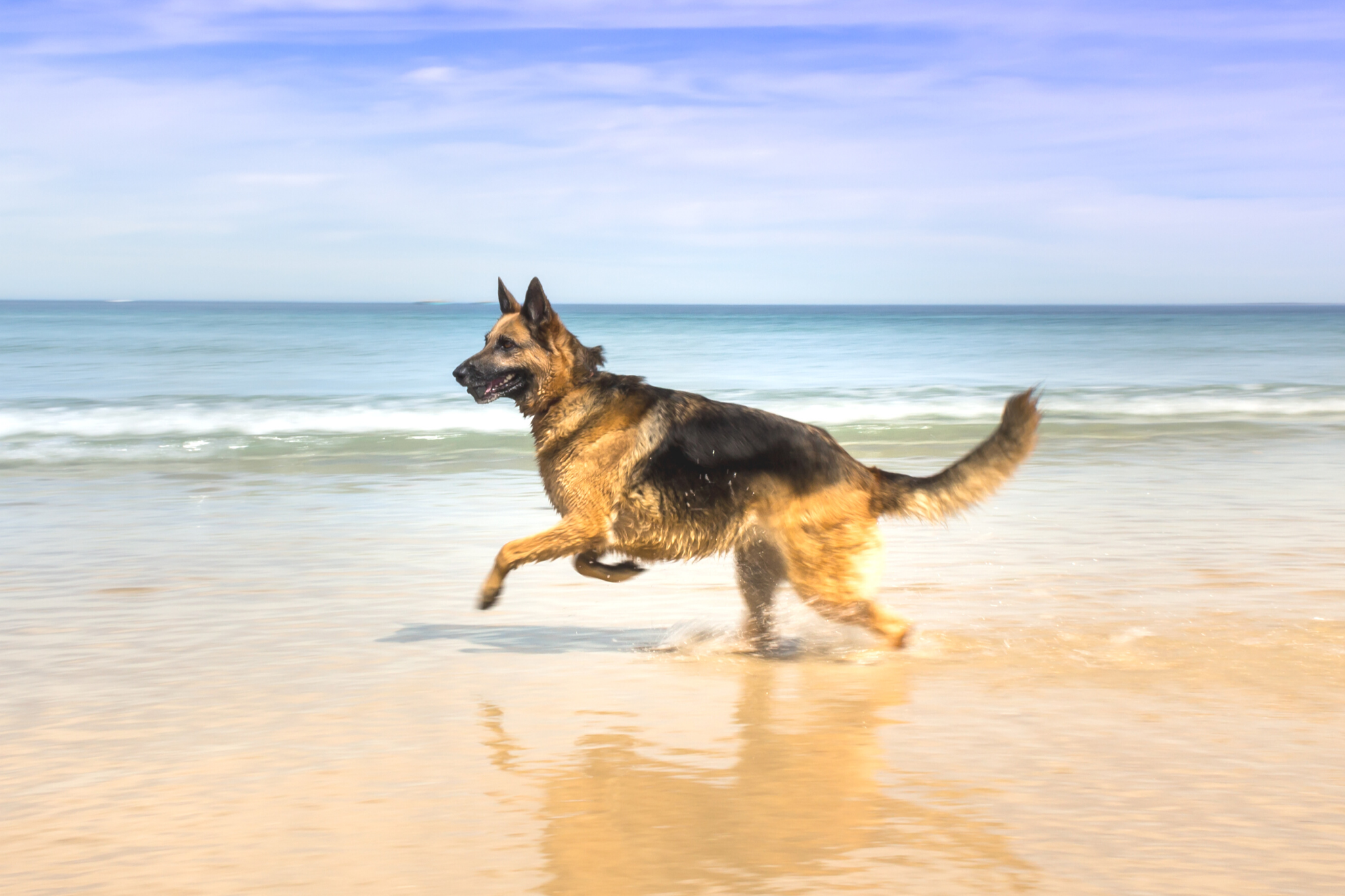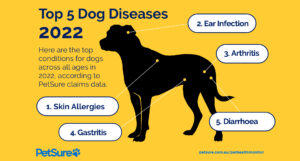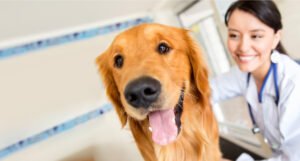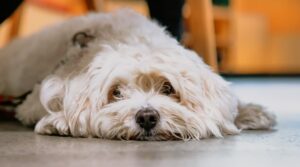German Shepherd | Traits | training | Typical health problems
This section outlines German Shepard’s traits, training and typical health problems.
German Shepherd | Breed highlights
| Breed: | The German Shepherd, also known as the German Shepherd Dog or Alsatian, is a large breed of herding dog. |
| Coat type: | German Shepherds are a doubled-coated breed: a softer and water-resistant undercoat and a thicker topcoat. The topcoat can be short, medium or long. |
| Shedding: | German Shepherds are naturally heavy shedders, with the amount of fur shed increasing during twice-yearly seasonal moults. |
| Grooming: | Regular brushing and more intensive grooming are required at the beginning of Spring and Autumn to remove the moulting underlayer. |
| Activity level: | An active and athletic breed, German Shepherds require a lot of exercise for physical and mental well-being. |
| Apartment friendly: | Not recommended |
| Small children: | Generally, the breed gets along well with children. However, as a puppy or adult, German Shepherds can be boisterous. Supervision is required. |
| Other dog friendly: | German Shepherds socialised with other animals from a young age tend to interact well with other dogs. |
What type of breed is a German Shepherd?
The German Shepherd is a large breed of herding dog. They are recognisable by their high-pointed ears, sharp muzzles, and muscular bodies, as well as being known for intelligence, loyalty, courage, athleticism, and strength. German Shepherds are top-ranking family dogs and continue working as important service dogs.
History of the German Shepherd
German Shepherds (known as Deutscher Schäferhund in German) originated in Germany in the late 1800s. A German army captain developed the breed to create a dog with exceptional herding abilities. The resulting breed established an outstanding reputation for herding livestock and became known for their attentive watchdog skills.
The German army famously employed the breed during World War I, where it’s estimated as many as 30,000 dogs served. They performed several tasks on the battlefield serving as sentries, messengers and ammunition carriers. They proved themselves especially capable in aiding wounded soldiers.
German Shepherd appearance and characteristics
Defined by their size, German Shepherds can grow as high as 63 centimetres and weigh up to 40 kilograms (female German Shepherds can be smaller). Black and tan is the most common colour of the breed; however, they can come in black, white, or a mix of hues. Their fur can be short, medium or long and is generally coarse in texture. Some German Shepherds have sloped backs: their spine curves toward the back legs, while others have straight spines. Sloped-backed German Shepherds may be more prone to health problems like hip dysplasia.
German Shepherd personality and temperament
German Shepherds have intelligent minds and are responsive to training. Obedience classes are recommended from an early age as this can help with socialising and provides the best setting for nurturing positive behaviours. However, it is worth noting while training assists on many fronts, German Shepherds are an assertive breed, and this trait can make them unsuitable for first-time dog owners.
German Shepherds are among the fewer dog breeds whose personality is more reserved. Their reserved disposition does not mean they are unfriendly, but they need time to work out the nature of new relationships. German Shepherds are instinctively alert to signs of danger, and this watchdog trait can extend to new or unfamiliar people. Although they can be aloof on first meetings, German Shepherds warm quickly and reveal themselves as loveable, playful and affectionate.
German Shepherd traits
Given the breed’s history as a working dog, a setting with plenty of activity is a must for a healthy and happy dog. While physical exercise like running and walking will keep your German Shepherd fit; add games like fetch to ensure their minds get a workout too.
While German Shepherds may not seem like a social breed, they prefer companionship over solitude. While they can withstand being alone for a short period, they can become anxious if left for too long. Boredom or loneliness may trigger behaviours such as excessive barking, digging or chewing.
German Shepherd Lifespan
German Shepherds generally live between 10 and 14 years.
The dos and don’ts of caring for a German Shepherd
Do: Ensure you purchase different brushes for grooming. Use a dog grooming brush regularly to remove topcoat fur and a specialised brush to remove fur from the undercoat (especially during seasonal moult).
Don’t: Thanks to their double coats, German Shepherds only need to be bathed occasionally. On average, wash once every three or four months or if your dog has become smelly or dirty. Overbathing strips out natural oils from the fur.
Do: Make sure you include regular paw and claw checks. Check paws for anything that looks or smells unusual, and ensure claws aren’t overgrown. To learn how to clip nails using a vet-approved method, watch PetSure’s Nail Clipping MasterClass.
Common Conditions for German Shepherds
| Conditions | Symptoms can include~ | Highest cost for a single treatment* |
| Gastrointestinal (tummy) problems | · Diarrhoea, vomiting or constipation. · Blood or mucous in stool/vomit. · Increased frequency/urgency passing stool. · Weight loss. · Loss of appetite and interest in food. · They may seem more tired than usual. | $7,603 |
| Traumatic Accidents, including bite injuries, wounds and broken bones | · History of trauma. · Wounds, scratches, pus, bleeding, swelling, heat, pain. · Limping, changes to movement. · Behaviour changes. · Broken claws. · Pain/tenderness | $10,757 |
| Ear Conditions -including infections and allergies | · Scratching, rubbing, or pawing at one of both ears. · Head shaking · Odour or discharge from the ears ·Ears may be red or warm to the touch | $11,063 |
| Skin Conditions, including – infections and allergies | · Scratching, biting, or rubbing the skin. · Signs of irritation, including red skin, scabs, bleeding, pustules, or weeping. · Hair loss, flaky skin, texture changes, lumps or an unusual or unpleasant smell. | $9,755 |
| Arthritis | · Limping on an affected limb/s · Stiffness on rising · Reluctance to jump or head up and down stairs · Swelling on pet’s legs | $7,277 |
Disclaimer: Reimbursement for these claims would be subject to limits, such as annual benefit limits or sub-limits, benefit percentage, applicable waiting periods and any applicable excess. Cover is subject to the policy terms and conditions. You should consider the relevant Product Disclosure Statement or policy wording available from the relevant provider.
* Please note that the values calculated are based on all claims for that condition and medically related conditions in each calendar year.
Types of pet insurance from PetSure
| Policy type | Policy description |
| Accidents | This product provides cover for specified accidental injuries up to an annual policy limit. Most policies will reimburse a stated Benefit Percentage that is typically 80% of eligible vet bills. Some condition sub-limits may also apply, with all annual limits resetting each year when the policy is renewed. It’s important to know that only defined accidents as listed in the policy’s Product Disclosure Statement will be covered (other conditions will not be covered). More information on what is typically covered and not covered in our find a policy page. |
| Basic care | This product provides limited cover for both specified accidental injuries and illness conditions, with a stated Benefit Percentage that can range from 60-90%. Treatments and medications for eligible conditions are typically covered subject to the applicable policy limits. Claimable conditions have an annual condition limit , meaning once the condition limit (subject to the annual benefit limit) has been reached in an annual policy period, costs relating to that condition will need to be covered entirely by the policyholder. However, annual benefit limits and applicable annual condition limits reset on renewal each year. More information on what is typically covered and not covered in our find a policy page. |
| Comprehensive / Accident and Illness | This product provides comprehensive cover for both specified accidental injuries and illness conditions, with a stated Benefit Percentage that will typically range from 70-85%. You can claim up to an annual maximum limit each year, which resets on renewal. Sub-limits for certain items may also apply. More information on what is typically covered and not covered in our find a policy page. |
Insurance products are issued by The Hollard Insurance Company Pty Ltd ABN 78 090 584 473, AFSL 241436 (Hollard) and/or PetSure (Australia) Pty Ltd ABN 95 075 949 923, AFSL 420183 (PetSure) (from 8 May 2023 only), administered by PetSure and promoted and distributed through their authorised representatives and distribution partners.
Any advice provided is general only and does not take into account your individual objectives, financial situation or needs. Cover is subject to the policy terms and conditions. Please consider the Product Disclosure Statement (PDS) to ensure this product meets your needs before purchasing, or choosing to continue with the product. PDS and Target Market Determination available on our partners’ websites. Meet our partners at petsure.com.au/partners.
Pet insurance can help by covering a portion of the eligible vet bill if the unexpected happens. Because it is difficult to predict the costs of veterinary care, it can help to have measures in place to help prepare for the unexpected. Check out our partner network and explore our policy tools to find a pet insurance policy.
Not all conditions or items are covered by Pet Insurance. Refer to the applicable Product Disclosure Statement for information about coverage and exclusions.
Frequently Asked Questions:
While German Shepherds are known as guard dogs, they are also considered gentle and loving. The breed is exceptionally loyal to their family – although they might show greater loyalty to one particular member.
What common health problems can affect German Shepherds?
· Gastric Dilatation-Volvulus
· Hip Dysplasia
· Elbow Dysplasia
· Some cancers, including Lymphoma
German Shepherds will bark to communicate. However, the breed is responsive to training and can learn to respond to commands like ‘quiet’ to curb their barking tendencies.
Did you know?
A German Shepherd has a star on the Hollywood Walk of Fame. Rin Tin Tin became an international movie star after being rescued from a World War 1 battlefield. He appeared in some 27 Hollywood films. After he passed away in 1932 at the age of 14, his sons and grandsons continued to work in the entertainment industry.
References
- German Shepherd Dog Council of Australia Inc “Breed History”: Accessed 13 May 2020
- German Shepherd Rescue Elite “The History and Origins of the German Shepherd Dog”
- MyPolice Queensland Police News, “My Story: Sergeant Jaye Lilley, Dog Squad”
- The Daily Shep, “A List of Famous German Shepherds Throughout History For Different Reasons“
- akc.org/dog-breeds/german-shepherd-dog/
- https://dogtime.com/dog-breeds/german-shepherd-dog#/slide/1
- https://www.hillspet.com.au/dog-care/dog-breeds/german-shepherd#:~:text=They%20need%20ample%20exercise%20daily,a%20few%20times%20a%20week
- https://www.australiandoglover.com/2015/10/german-shepherd.html
The author of this article has been updated. Dr Claire Sharp was attributed as the author, and we unreservedly apologise to her and to the author for crediting her as the author of the article.
Pet insurance can help by covering a portion of the eligible vet bill if the unexpected happens. Because it is difficult to predict the costs of veterinary care, it can help to have measures in place to help prepare for the unexpected. Check out our partner network and explore our policy tools to find a pet insurance policy.
Not all conditions or items are covered by Pet Insurance. Refer to the applicable Product Disclosure Statement for information about coverage and exclusions.



 Fact checked
Fact checked





